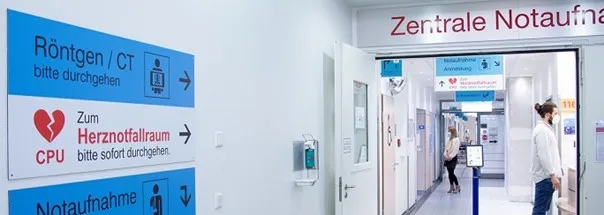ZNAflow

INITIAL SITUATION
An increasing number of patients and the lack of connectivity between the players involved in outpatient emergency care are some of the structural problems that currently burden the central emergency rooms (German: Zentrale Notaufnahme, short ZNA). A particular challenge is posed by so-called crowding situations, in which an unexpectedly high volume of patients appears and timely care cannot be ensured in accordance with the urgency of treatment. This leads to increased patient hazard and reduced treatment quality.
PROJECT AIM
The project ZNAflow therefore aims to develop an interactive, AI-based user-centered assistance system that can access internal data sources, external data sources, and interfaces for downstream IT systems. This system makes it possible to optimize the admission, treatment and discharge or transfer of patients by forecasting the number of patients in the ZNA and a data-based (partial) control of patient flows in the ZNA. This is done through a targeted derivation and prescription of appropriate, timely and prioritized actions. The information of the AI-based assistance system can also be used for the early control of self-referrals, so that all patient access points to the ZNA can be addressed. The data-based support of process control in the ZNA will open up further opportunities for optimization in the long term.
VALUE
By using the AI-based assistance system developed as part of the ZNAflow project, the risk of patient hazard in the emergency department can be reduced and the quality of treatment in general promoted, especially in phases of high traffic, the now predicted crowding situations. Patients also benefit from shorter overall waiting times in the ZNA before and between admissions, diagnostic and treatment steps. From a staff perspective, work satisfaction is promoted as partial automation and coordinative support provide relief for staff in stressful situations. ZNAflow concerns one of the most important parts of society: our health.
REALIZATION
The main realization steps include requirements elicitation, demonstrator development, field evaluations with user studies and, finally, transfer and deployment. In this way, the interactive, AI-based assistance system will be integrated in the best possible way into the existing processes of the ZNA and adjacent areas.
To elicit the requirements, suitable processes and interaction points within the ZNA will first be identified and defined in close cooperation with the users of the AI-based assistance system. During the development of the demonstrator, a domain-specific artifact model is used for the structured collection of the requirements of AI systems in the hospital environment. An initial training of the model is done with existing, historical data and by integrating internal and external data the model is extended. In addition, user acceptance of AI-based solutions in the ZNA will be evaluated with patients and staff through field evaluations and user studies. Interviews, workshops, and on-site observations with users will be used to systematically assess the added value of the demonstrators through qualitative and quantitative evaluation criteria and metrics.
The analysis of the existing IT architecture and the involvement of the users ensure interoperability and suitability for everyday use. In the concluding transfer and deployment, a process model is designed in order to make the results available to the research and to maintain general validity. A permanent focus in the development of the AI-based assistance system is also on regulatory compliance and the integration of ethical considerations.
STAKEHOLDER
For the efficient and targeted realization of the described AI-based assistance system,
- Technical University of Munich (TUM)
- fortiss GmbH
- AGAPLESION gemeinnützige AG
- DOCYET GmbH
- AGAPLESION EVANGELISCHES KRANKENHAUS MITTELHESSEN gGmbH
act as collaborative partners and are responsible for different objectives of the project.
ADDITIONAL INFORMATION
https://www.interaktive-technologien.de/projekte/znaflow
RESEARCH FUNDING
ZNAflow is funded by the German Federal Ministry of Education and Research (BMBF).
Contact
Prof. Dr. Helmut Krcmar
Dr. Andreas Hein (Contact Person)
Cornelius Born, M.Sc.